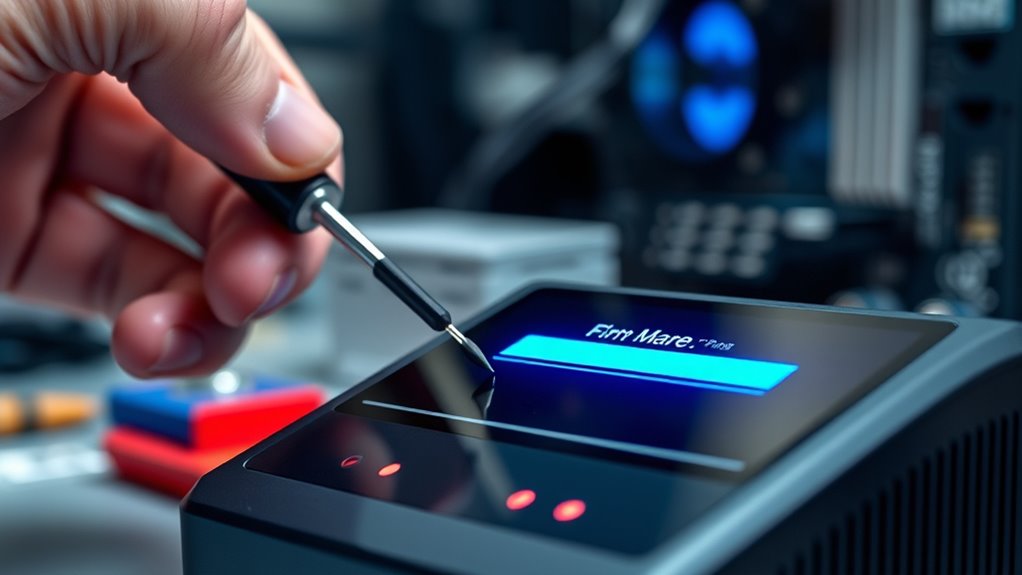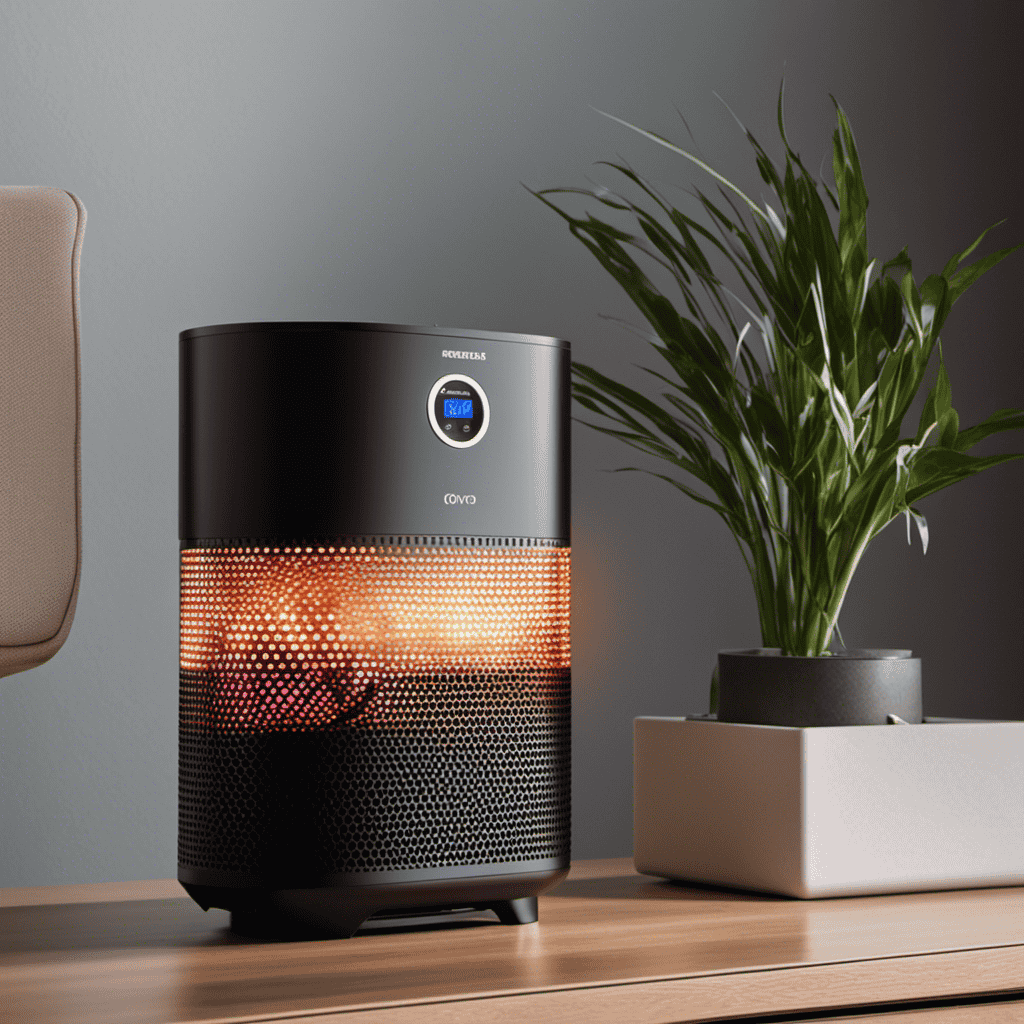You should upgrade your firmware whenever new updates are released by the manufacturer or if you notice issues like crashes or slow performance, as updates fix bugs, boost security, and improve compatibility. Regularly checking for updates helps keep your device running smoothly and protected against cyber threats. Neglecting updates can cause malfunctions and vulnerabilities. Staying current with firmware is essential for maximum device performance, and understanding more about this will help you keep your devices secure and efficient.
Key Takeaways
- Upgrade firmware when new versions are released to access security patches, bug fixes, and performance improvements.
- Consider updating if the device exhibits issues like crashes, slow responses, or connectivity problems.
- Regular updates ensure compatibility with new peripherals, software, and hardware standards.
- Neglecting firmware upgrades increases vulnerability to cyber threats and device malfunctions.
- Incorporate firmware updates into routine maintenance to maintain optimal device operation and security.

Firmware upgrades are essential for keeping your devices secure, efficient, and functioning properly. When you update your firmware, you ensure that your hardware operates smoothly and stays protected against emerging threats. One of the main reasons to upgrade firmware promptly is to maintain hardware compatibility. Manufacturers often release updates to improve how your device interacts with new peripherals, software, or other hardware components. If you neglect these updates, you risk facing issues like device malfunctions, reduced performance, or incompatibility with new technologies. Keeping your firmware current guarantees that your hardware can handle the latest innovations and standards, preventing frustrating disruptions.
Security patches are another critical aspect of firmware upgrades. Cyber threats evolve rapidly, and outdated firmware can leave vulnerabilities open for exploitation. Hackers often target outdated systems to gain unauthorized access or deploy malware. By upgrading your firmware, you ensure that security patches are applied, sealing known vulnerabilities and reducing your risk of cyberattacks. These patches strengthen your device’s defenses, making it more resilient against threats that could compromise your data or disrupt your operations. Regular firmware updates act as an essential part of your cybersecurity strategy, especially for devices connected to the internet or handling sensitive information.
You should consider upgrading firmware whenever manufacturers release new versions. These updates often include important security patches, bug fixes, and performance improvements. Ignoring them can lead to degraded device performance, increased vulnerability, or incompatibility issues down the line. It’s also a good idea to check for firmware updates if you notice any abnormal device behavior, such as crashes, slow responsiveness, or connectivity problems. Sometimes, updates are released specifically to address these issues, providing a quick fix that restores ideal function. Additionally, understanding the importance of firmware updates can help you better appreciate the role of refrigeration cycle efficiency and maintenance in your overall system performance.
Timing matters when it comes to firmware upgrades. Don’t wait until your device is already experiencing problems or before a security breach occurs. Instead, make it a routine part of your device maintenance. Set reminders to check for updates regularly or enable automatic updates if your device supports them. This proactive approach ensures you’re always protected with the latest security patches and improvements, minimizing risks and maximizing performance.
Frequently Asked Questions
How Often Should I Check for Firmware Updates?
You should check for firmware updates regularly, ideally once a month, to guarantee peak performance. Update frequency depends on the device and manufacturer recommendations, so stay informed. Keeping your firmware current improves software compatibility, fixes bugs, and enhances security. Don’t wait too long to check—outdated firmware can cause issues. Make it a habit to verify updates often, especially if you notice performance problems or new features released.
Can Firmware Upgrades Improve Device Security?
Think of firmware upgrades as a security guard patrolling your device. Yes, they can improve device security by patching vulnerabilities and fixing bugs. Upgrades also enhance device compatibility with new features and guarantee update reliability. Skipping updates leaves your device exposed, like an unguarded building. Regularly updating firmware keeps your device safe, stable, and compatible, giving you peace of mind knowing your digital environment is protected and functioning smoothly.
What Are Potential Risks of Ignoring Firmware Updates?
Ignoring firmware updates can leave your device vulnerable to firmware vulnerabilities that hackers often exploit. You might miss important update notifications, delaying essential security patches. This increases the risk of unauthorized access, malware infections, and data loss. Regularly updating firmware helps protect your device and personal information. Don’t dismiss update alerts; staying current guarantees you minimize these risks and keep your device functioning securely and efficiently.
Are Firmware Updates Compatible With All Device Models?
Like a well-tailored suit, firmware updates aren’t universal; they vary by device. You need to check device compatibility before updating, as not all firmware works with every model. Manufacturers release updates with specific hardware in mind, so update frequency depends on your device’s needs and support. Skipping or forcing incompatible updates can cause issues, so always verify compatibility to keep your device running smoothly and securely.
How Do I Know if a Firmware Update Is Successful?
To know if a firmware update is successful, you should perform an update verification by checking the device’s firmware version after the process completes. Look for confirmation messages or indicators on your device. If something goes wrong, you might need to contemplate a firmware rollback. Always ensure the update process finishes without interruptions, and restart your device to confirm it runs smoothly with the new firmware.
Conclusion
Just like a wise sailor updates their chart before setting sail, staying current with firmware keeps your device safe and efficient. Ignoring updates is like sailing into uncharted waters without a map—risky and unnecessary. By upgrading when needed, you’re steering confidently through digital storms, ensuring smooth sailing ahead. Remember, in the ever-changing tech world, staying updated isn’t just a choice; it’s your compass to performance and security. Keep your device shipshape and navigate with confidence.










